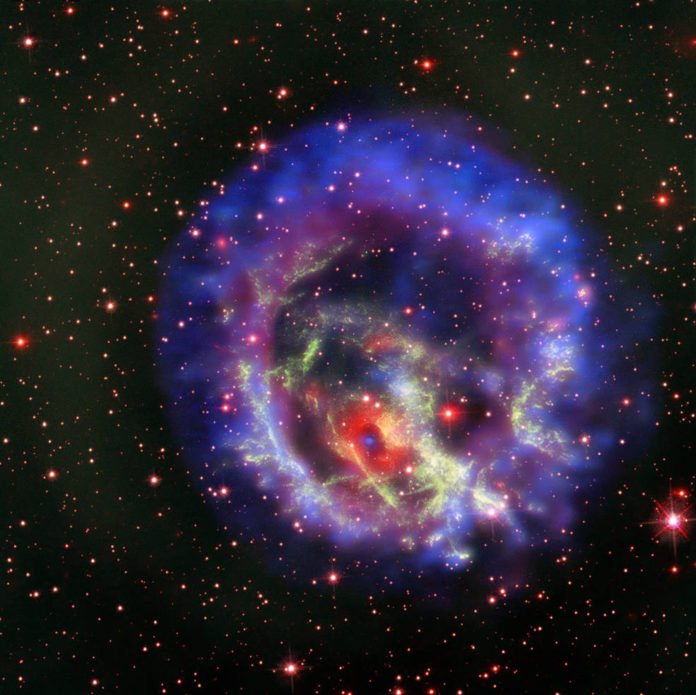NASA astronomers have identified a special kind of neutron star, a rare variety that has both a low magnetic field and no stellar companion, outside of the Milky Way galaxy. The star is located within the remains of a supernova – known as 1E 0102.2-7219 (E0102 for short) – in the Small Magellanic Cloud, located 200,000 light years from Earth.
The image was captured by NASA‘s Chandra X-ray Observatory and the European Southern Observatory’s Very Large Telescope (VLT) in Chile. Detection of the star allows scientists to learn new details about this object that was discovered more than three decades ago.
In this image, X-rays from Chandra are blue and purple, and visible light data from VLT’s Multi Unit Spectroscopic Explorer (MUSE) instrument are bright red. Additional data from the Hubble Space Telescope are dark red and green.
The observations of E0102 show that the supernova remnant is dominated by a large ring-shaped structure in X-rays, associated with the blast wave of the supernova. The new MUSE data revealed a smaller ring of gas (in bright red) that is expanding more slowly than the blast wave. At the center of this ring is a blue point-like source of X-rays. Together, the small ring and point source act like a celestial bull’s eye.
The combined Chandra and MUSE data suggest that this source is an isolated neutron star, created in the supernova explosion about two millennia ago. The X-ray energy signature, or “spectrum,” of this source is very similar to that of the neutron stars located at the center of two other famous oxygen-rich supernova remnants: Cassiopeia A (Cas A) and Puppis A. These two neutron stars also do not have companion stars.
The absence of confirmation for broadened radio emission or pulsed X-ray radiation, typically associated with quickly rotating very polarized neutron stars, shows that the astronomers have recognized the X-radiation from the hot surface of an isolated neutron star with low magnetic fields. Around ten such protests have been identified in the Milky Way galaxy, yet this is the first recognized outside our galaxy.
But how did this neutron star end up in its current position, seemingly offset from the center of the circular shell of X-ray emission produced by the blast wave of the supernova?
Astronomers suggested that the supernova explosion occurred close to the center of the leftover, however, the neutron star was kicked away the site in an awry blast, at a rapid of around two million miles per hour. Be that as it may, in this situation, it is hard to clarify why the neutron star is, today, so flawlessly surrounded by the as recently found ring of gas seen at optical wavelengths.
Another conceivable clarification is that the neutron star is moving gradually and the current position is generally where the supernova explosion happened. For this situation, the material in the optical ring may have been ejected either amid the supernova explosion or by the doomed progenitor star up to a few thousand years before.
A challenge for this second scenario is that the explosion site would be located well away from the center of the remnant as determined by the extended X-ray emission. This would imply a special set of circumstances for the surroundings of E0102: for example, a cavity carved by winds from the progenitor star before the supernova explosion, and variations in the density of the interstellar gas and dust surrounding the remnant.
Future observations of E0102 at X-ray, optical, and radio wavelengths should help astronomers solve this exciting new puzzle posed by the lonely neutron star.
A paper describing these results was published in the April issue of Nature Astronomy and is available online.
